Introduction
The current-sense on the MAX1737 is more accurate than stated in the data sheet. The data-sheet limits represent 6-sigma numbers and are very conservative. Sample test data suggests approximately a 4-sigma limit. The current-sense parameters that can be improved are the battery full-scale current, input full-scale current, and the full-charge termination threshold. These parameters are explained below, with new equations where needed.CS-to-BATT Full-Scale Current Sense: 200mV ±4mV
Most of this error is offset error. Consequently, the ±4mV error remains constant as the CS voltage is reduced. The CS resistor value can be reduced as long as a 5mV error in the full-scale current-sense voltage is acceptable. The full-scale current error is 5mV/Rcs.CSSP-to-CSSN Full-Scale Current-Sense Voltage: 105mV ±4mV
The input current-sense error is the same as the battery-sense error, and is more accurate than the data-sheet spec. However, there are some filtering and noise-related errors at the CSSP and CSSN inputs because the current is not DC at this point. Because of these noise-related errors, for best accuracy set the input current sense about 2% lower than the target. The noise-related errors depend on input voltage, inductor, capacitors, but are repeatable from unit to unit. Once the board is designed, ISETIN or the input current-sense resistor (R12) can be slightly adjusted to remove the noise error. All later units will have the same input current setting.Full-Charge Termination Threshold
The MAX1737's full-charge termination detector works differently from the full-scale current sense. The full-charge termination threshold voltage does NOT change when ISETOUT is changed. It is only a function of RCS. So if the CS-to-BATT current-sense resistor is lowered from 0.1Ω to 0.05Ω, and ISETOUT is set to 0.5 REF (to maintain the same fast-charge current, but with a lower RCS), the full-charge termination current increases. However, it may not double because the MAX1737 senses the peak inductor current for this function and not the average battery current (see Figure 1).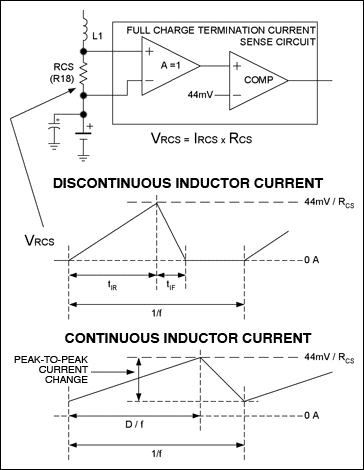
Figure 1. Full-charge termination detection circuit and inductor current waveforms. Full charge is indicated when peak inductor current falls below 44mV/RCS. The battery charging current that corresponds to this peak current is a function of inductor value and input voltage, and can be calculated as described in the text.
The data-sheet spec for the BATT charge current full-charge termination threshold is 44mV +11mV/-10mV. This is a very conservative specification. A reliable limit can be 44mV ±4mV. But this threshold senses when the peak inductor current (not average DC charging current) falls below this point. With a 0.1Ω RCS, the peak inductor current must fall to 440mA to reach the threshold. At low current in voltage mode, the average charging current is much less than the 440mA peak inductor current, but can be calculated as shown in the Calculating Full-Charge Termination Threshold section below.
If the current-sense resistor is lowered to 0.05Ω, the full-charge termination threshold is still 44mV (and does not change with ISETOUT). The inductor peak current must then fall below 880mA to trigger the comparator. This means that the average current that trips the full-charge termination threshold will be higher with 0.05Ω than with 0.1Ω, even if ISETOUT is used to set the same 2A fast-charge current in both cases.
The ratio between the peak inductor current and the average charge current depends on the inductor value, output voltage, and input voltage. Fortunately, the input voltage is usually a regulated supply and is known. The output voltage is also known because the charger is in voltage mode when the full-charge termination occurs, so it will be 4.2V times the number of cells. Since the inductor value is also fixed, the full-charge termination threshold will be quite consistent from board to board.
Note: the term "BATT charge current full-charge termination threshold" used in the MAX1737 data sheet is somewhat misleading because charging does not actually stop when the battery current falls to this level. The FULLCHG-bar and FASTCHG-bar are both high in this state, indicating that the battery is full (see Figure 2), but charging still continues in top-off mode until the top-off timer times out.
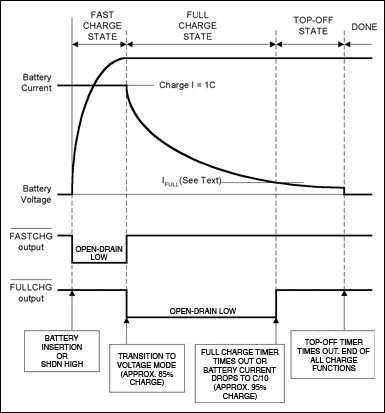
Figure 2. Charge state and indicator timing for a typical charging sequence. Full battery is indicated when FULLCHG-bar goes high with FASTCHG-bar already high. This occurs when battery charging current falls to IFULL, as described in the text.
Calculating the Full-Charge Termination Threshold
The "BATT charge current full-charge termination threshold" is triggered when peak inductor current falls tNote again that IPKTERM is only a function of RCS and does not change with ISETOUT.
The battery current, IFULL, is the average value of the inductor current. IFULL is a function of RCS, input voltage (VIN), battery voltage (VBATT), and inductor value (L). It can be calculated as follows for the two cases where inductor current is discontinuous (I>FULL(DISC)) or continuous (IFULL(CONT)).
Most MAX1737 charger designs have discontinuous inductor current near the end of charging when the battery current is small. Assuming discontinuous current, the average current is:
Where IPKTERM = 44mV/RCS, tPER is the period of the switching frequency (1/300kHz = 3.33μs), and tIU and tID are the inductor-current ramp-up and ramp-downtimes. These are:
Since the charger is in voltage mode when calculating IFULL, VBATT is the lithium-ion (Li+) termination voltage (usually 4.2V per cell).
As an example, when charging a 2-cell Li+ battery from a 12V input with RCS = 0.1Ω and L = 10μH:
If ((tIU + tID) / tP) is 1 or greater, this indicates that the inductor is still continuous when its peak current is IPKTERM. This can occur with larger inductor values. The battery charging current is then:
Where D is the switch duty factor, which for a step-down switching regulator is VOUT / VIN, or for the MAX1737, D = VBATT / VIN.
If 22μH is used instead of 10μH in the above example, you get:
The charge current is then:
 電子發(fā)燒友App
電子發(fā)燒友App











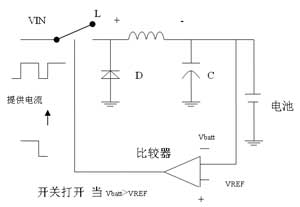
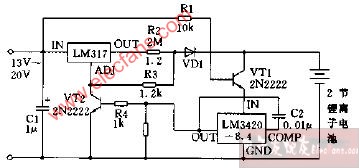
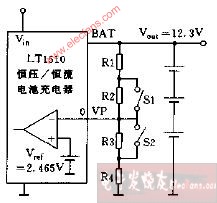
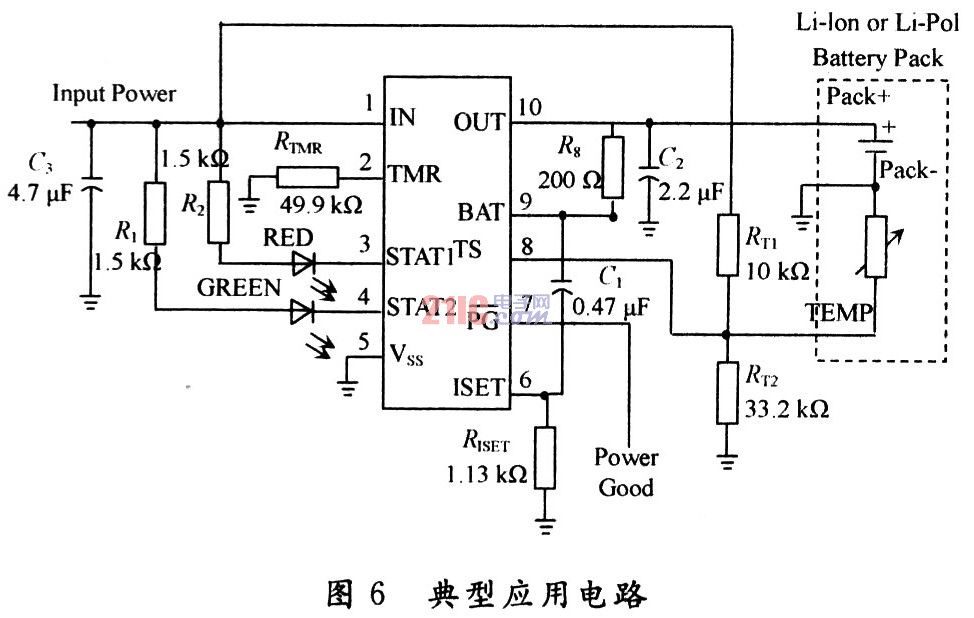

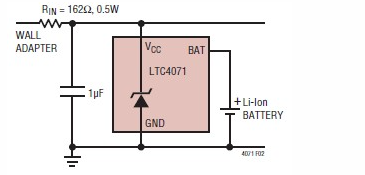
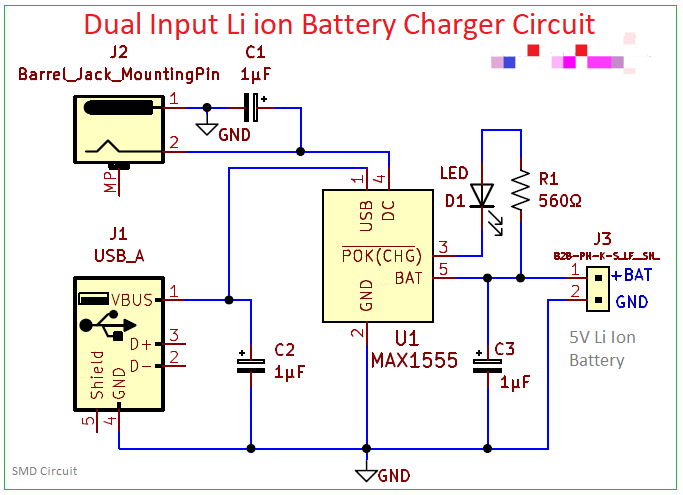










評(píng)論